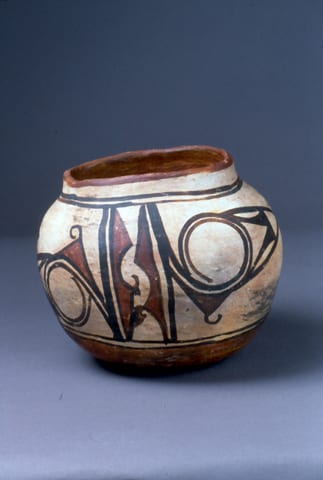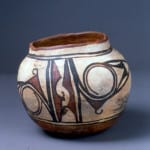Hopi Polacca C pot with Zuni Rain-Bird Design, 1860-1890, circa 1870s probably.
Wade and McChesney describe this category of bowls:
———-
“Class VIII: Form: Squat globular jar with bulbous midbody, diminutive, rounded, shallow bases lacking kickups and constricted, sharply concave neck, Greatest width at midbody, which equals or is slightly larger than the vessel’s height. Rims are straight or rounded.
Design: The neck is either left plain or arranged with a zonal layout. The midbody is the primary design field and is tonally composed or internally subdivided into four to six panels. When underbody is not slipped red then the midbody design is often extended onto its surface. Rims are painted red…commercialization of Hopi ceramics began during the Style C period, sometime in the 1880s. Classes of objects…show signs of mass production. Designs become limited and standardized …ornamentation was more important than function. In addition, many vessels in the Keam Collection show no indication of use.
Form: Jars…differ from Style B jars in a foreshortening of the midbody and in lacking the sharp flexure at the junction of the mid- and underbodies. Otherwise they are quite similar…Concave bases rarely appear.
Surface treatment: Heavy matte kaolin slip that crazes. Slip appears to have been carelessly rag-wiped and polished. The red underbody slip varies in thickness and is texturally coarse….Pigments adhere poorly to the surface and can be smeared or rubbed off with light pressure.
Design layout: During the Polacca tradition negative space came to be thought of as a background to be painted rather than as a source of potential motifs to be laid out and drawn into the total composition. With Style C ceramics the background orientation became even more pronounced. Designs were placed as on a flat white canvas with minimal concern for the negative forms created by their juxtapositions. This contributes to the feeling of sloppiness in Style C compositions, even when the painting is well executed. The ignored background shapes intrude into the design and distort its symmetry. With the exception of an arabesque style common to stew bowls (as on pot 1990-03), most other Style C compositions are less complex than those used during the A and B periods (1981: 568 and 143).”
———-
Wade (1980a:60) also notes that “there was a minor change from the fine white slip used on Style A and B ceramics to a more granular white kaolin slip and red underbody slip. Decorative systems used on the Style C vessels layout, motifs and individual elements, strongly correspond to the design of classic Zuni Polychrome dating from the mid-nineteenth century until the present.” Although I have no Style A or B pots for comparison, this granular slip is evident on 1994-14. Note that 1994-14 is a direct design ancestor to Fern Lalo’s unusual modern “rain bird” design (1992-04). For an example similar to 1994-14 in the Keam collection, see Wade and McChesky (1981:353, KM#832). For other pots with the Rain Bird design and for other Polacca-ware pots and in the collection, see the Category List.
Mark Sublette describes the pot as “Polacca B,” but acknowledges it as possibly “C.” “This piece was collected approximately 20 years ago out of the San Felipe Pueblo in New Mexico by Tom Kolter of Tucson, Arizona.” [Letter on file.] Kolter advertised the pot for sale as “old San Felipe” in a Tucson paper.


